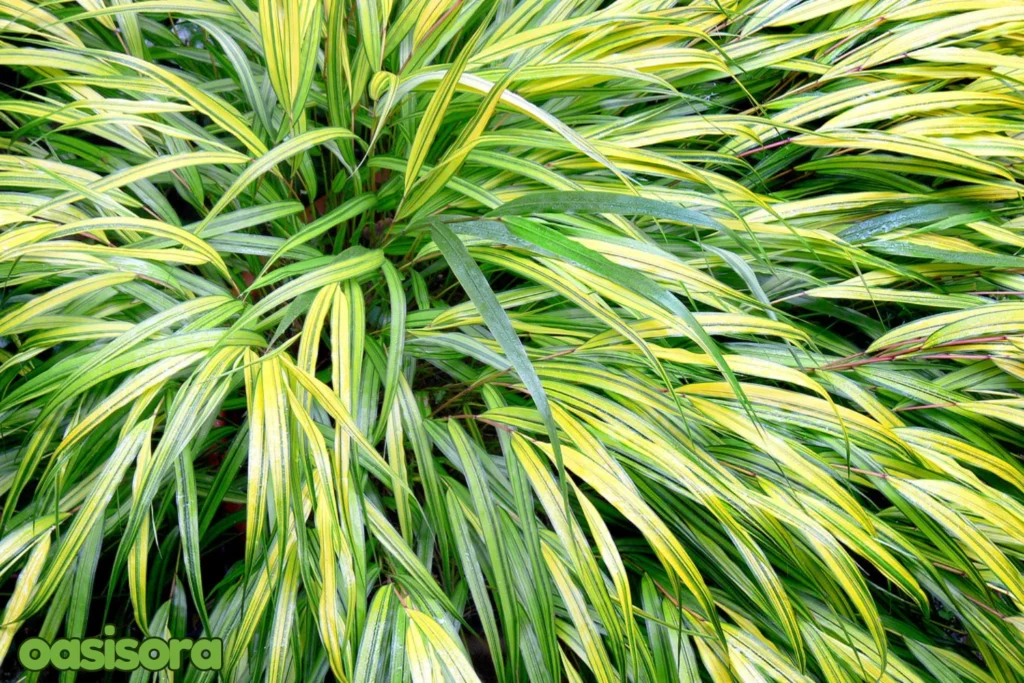
Ideal Japanese garden grass is essential to form a calm and organic atmosphere. The rich greenery and gentle appearance that mix well with the plants, water features, and stones can increase your landscape’s harmony.
Appropriate grass makes your garden manageable and easily grows while conserving its attractiveness.
The focus on simplicity and harmony in traditional Japanese gardens is reflected through your ideal grass placement. With suitable grass and proper management, you can upgrade your garden into a wonderful place of calm and relaxation.
Let’s examine some favourable kinds to attain this classic look with essential tips to maintain top grasses.
The Role of Grass in Creating the Serene and Natural Ambiance of Japanese Gardens
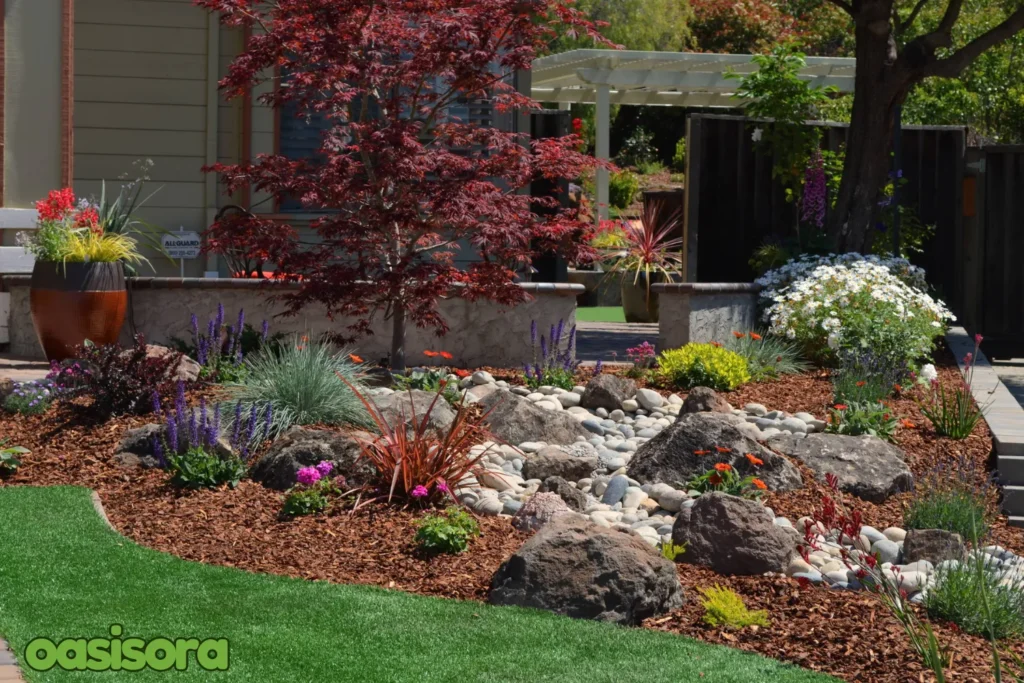
Natural Ambiance of Japanese Garden
In Japanese garden design, grasses play an essential role as their presence promotes the landscape’s symmetry and charm. It changes the overall appearance by filling in open areas and fitting in perfectly with organic characteristics like stones and water features.
The yard feels more peaceful and welcoming because of the comforting impact of the soft grass. The improper pick can disturb harmony, while the perfect one may strengthen the garden’s soothing impact.
Japanese gardens support Zen’s harmonious relationships, balance, and simplicity.
These concepts are apparent in your choice of grass with a natural, fresh look. The proper grass may be applied as ground cover or as a feature to help create a peaceful area ideal for meditation and comfort.
Popular Grass Types for Japanese Gardens
Different textures and patterns of several grass varieties improve the overall beauty. However, it’s essential to note the key factors that affect the growth and maintenance of specific types before choosing them.
Factors to Consider When Choosing Grass for Japanese Gardens
Several practical choices should be noted while looking into certain grass varieties:
- Climate: If some grasses prefer warmer climates, the rest do best in regions with less moisture. Select a kind that is compatible with the climate in your area.
- Sun Exposure: While some grasses survive in full sun, others appreciate partial shade. Before finalizing, analyze your garden’s light conditions.
- Garden Size: For the vast outdoors, look for low-maintenance and slow-grower grasses. Attractive species sometimes give better outcomes for tiny decorative areas.
- Maintenance Requirements: Prioritize grasses with less watering and pruning needs for your low-maintenance landscapes.
By considering these aspects, you can select the ideal Japanese garden grass that matches your area and any nearby natural components.
Disclaimer: The plant list and descriptions here are based on selections made by Yoko Kawaguchi in her publication ‘‘Authentic Japanese Gardens”. The content details are just for reference purposes and are not meant to violate any rights of the publisher or author.
Top Grass Varieties for Japanese Gardens
Many types of grasses exist in Japanese gardens to increase their organic beauty and balance. Each variety contributes a unique feel and style that strengthens the peaceful setting of the garden.
Here, we go through the major grass types of zen gardens to reflect their unique qualities and necessary tips for their maintenance.
- Carex hachijoensis (Evergold Sedge)
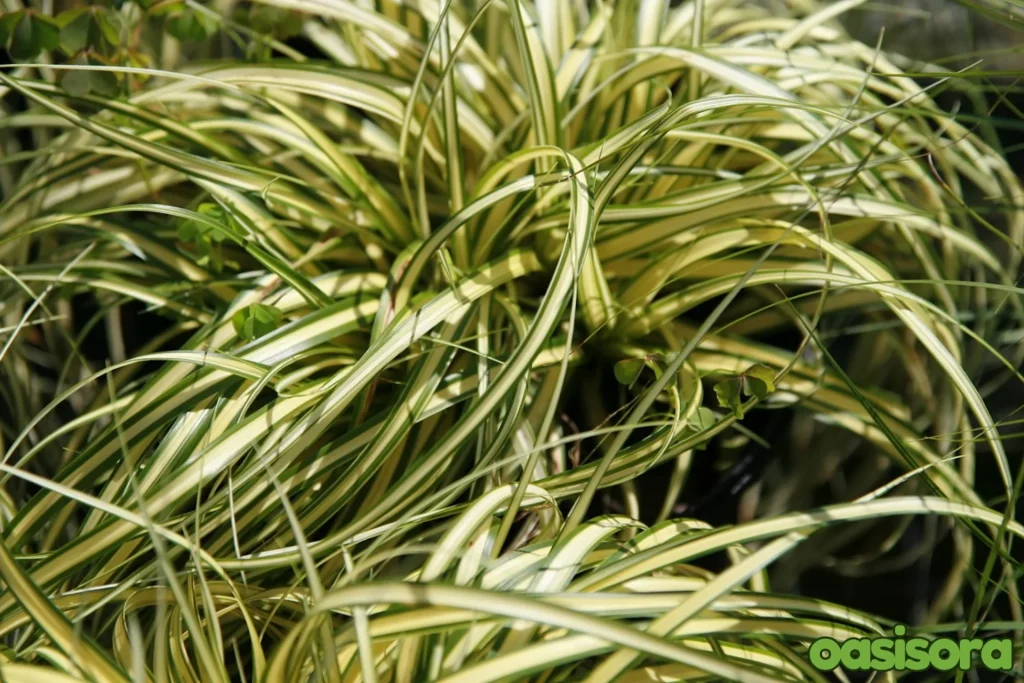
Carex hachijoensis Evergold Sedge
Carex “Evergold” is an adaptable, evergreen garden grass that gives Japanese gardens variability and a pop of color with its bright green and golden leaves.
The bright yellow middle stripe on its slim, curving leaves gives it a gentle yet classy look. This kind is fantastic for imparting richness and color to changed garden settings as it grows well in shady spots.
Tips for Taking Care:
Requires relatively little maintenance.
In the fall or early spring, light trimming helps them grow.
Disease and insect resistance allows smooth growth and development.
- Hakonechloa macra (“Aureola”)
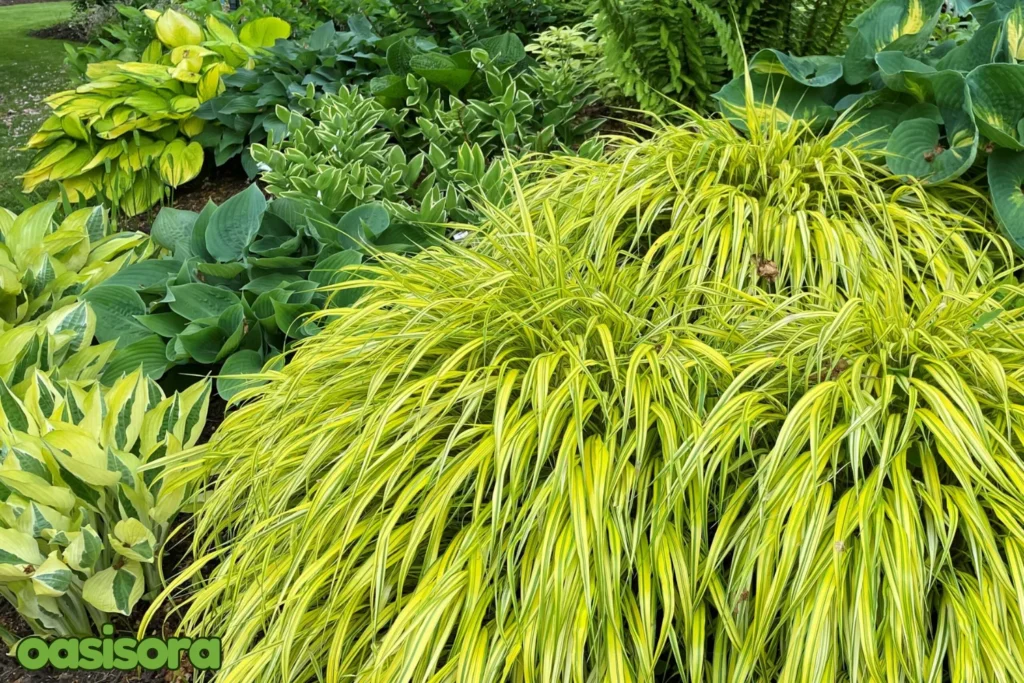
Hakonechloa macra ‘Aureola’
A popular zen garden grass Hakonechloa macra ‘Aureola’ possesse a unique delicate structure. It is among a lovely and colorful variety of Japanese forest grass that produces masses.
In Japanese gardens, its bright gold leaves with green stripes produce an exciting contrast. In autumn, its reddish leaves provide seasonal interest.
This grass grows well in complete or partial shade, specifically in areas that are close to water characteristics, stones, and walkways. It blooms in unique garden settings that are often challenging for other grasses to grow.
Care Tips:
These are slow-growing grasses requiring very little attention
Grow well in the presence of wet, well-drained soil and regular watering.
Develops easily if it provides resistance to pests and diseases.
Deer resistance promotes longevity in outdoor settings.
Early springtime moderate pruning helps fresh growth.
- Imperata cylindrica (Japanese Blood Grass)

Imperata cylindrica (L.) Raeusch
Imperata cylindrica is an outstanding, attractive Japanese garden grass that constantly develops the color of its unique red-tipped blades during the growing season.
This colorful grass is fantastic for presenting exciting effects along pathways, rocky gardens, or water elements because it appears in contrast with the green and neutral tones of your Japanese garden.
Blood grass performs efficiently in direct sunlight to modest shade with damp, well-drained soil.
Tips for Taking Care:
Very little care is required.
For the best color, it grows in full sun to moderate shade.
Need frequent monitoring to prevent it from growing larger.
Hazardous in some places, so verify local laws before planting.
To promote fresh shoots, cut precisely in the late winter or early spring.
- Miscanthus sinensis (Chinese Silvergrass)
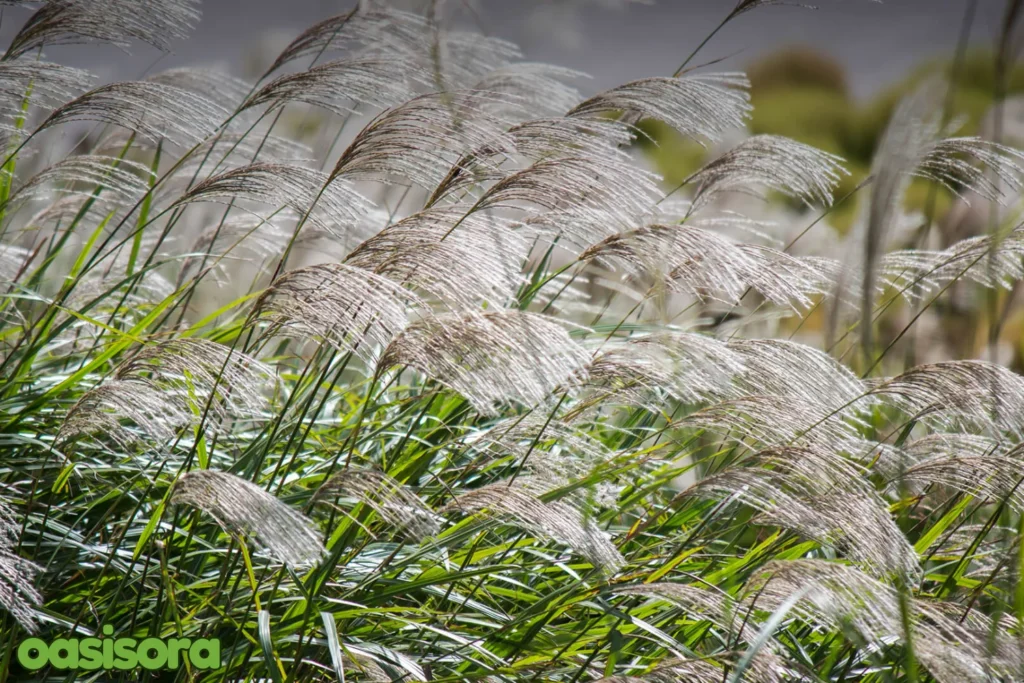
Miscanthus sinensis Chinese Silver
A straight, beautiful grass Miscanthus sinensis gives elegance and flair to the Zen spots. As they gently move in the air, their silvery plumes present a fascinating element in your outdoor area.
Serving as Ideal for background planting or as the center of attention next to water features or stone arrangements, this grass type is perfect for giving symmetry and balance.
Versatile for various soil types, from moist to dry, makes it adjustable to different garden settings.
Tips for Taking Care:
Easily grow with little care, so frequent monitoring is necessary to stop the spread.
For best plume growth, it flourishes in broad sunlight.
Though it is capable of withstanding a range of soil conditions, it favors well-drained soil.
In areas where it might overtake native plants, consider safe alternatives of such grasses.
Due to its spreading nature, make sure you review local rules before planting them.
- Phragmites australis (Common Reed)

Common Reed (Phragmites australis)
Favorable in humid conditions, Phragmites australis is an ideal plant for landscapes with striking water bodies like ponds or streams.
Its long, soft stems and natural appearance give the yard a wild, untouched element that contributes to its peaceful, natural attraction. Setting this reed at the edge of the lake or in moist soil can give prominence and color to your landscape.
Care Tips:
Grow well under full sun and moist soil.
Due to its highly invasive nature, regular monitoring saves it from replacing the vegetation.
Check local rules for managing and planting such grasses.
- Muhlenbergia capillaris (Pink Muhlygrass)
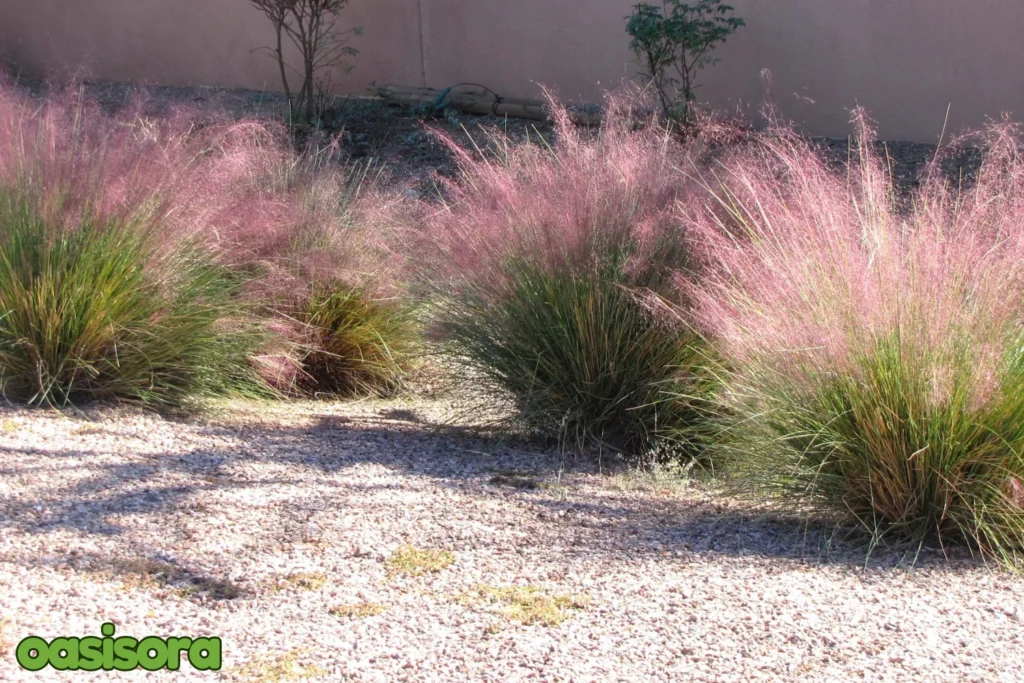
Pink Muhly Grass (Muhlenbergia)
In fall, Pink Muhlygrass, having pink flower plumes, offers a shining appearance to the light and conveys a soft and airy feel.
In Japanese gardens, its sensitive fluffy blossoms bring a charming touch while providing a great ground cover or display plant. Full light is beneficial for it to flourish well in rough or sandy soils.
Care Tips:
Prefers slightly moist soil and full sunlight.
It needs little management when it’s properly set up.
Such a type can withstand dry conditions.
- Schizachyrium scoparium (Little Bluestem)

This is Schizachyrium scoparium
A medium-sized, drought-tolerant Little Bluestem grass presents aesthetic character to your garden. Seasonal beauty arises as its blue-green color in summer becomes reddish-bronze in the autumn period.
Besides producing well in various soil types, this resistant to disease grasses assists in minimizing erosion on dry areas and slopes.
Advice for Taking Care:
Choose a full sun-to-light shade and well-drained soil for its plantation.
Minimal care for its setup.
To promote new development, prune back faded leaves in late winter or early spring.
Efficient for decreasing erosion in hot or sloped surfaces.
- Sorghastrum nutans (Indian Grass)

Sorghastrum nutans (Indian Grass)
Sorghastrum nutans, with its golden seed heads that grow in the late summer and fall, is a medium-to-tall, sized grass.
It is an ideal fit for dry or prairie-style portions of a Japanese garden due to its warm colors along with its straight growth, offering a natural and authentic appearance.
Tips for Taking Care:
Use light fertilized soil that drains properly and receives full sun.
Tolerant of dryness once it develops.
For regrowth, pull back damaged leaves during late winter.
- Sporobolus heterolepis (Prairie Dropseed)

Prairie Dropseed Grass, Sporobolus
Prairie Dropseed is a smooth, fountain-like grass with an elegant look that improves garden borders. Its tiny seed heads generate a pleasant scent that contributes to the sensory delight.
In dry, well-drained spots, cultivate sporobolus grass since it grows successfully in natural settings.
Care Tips:
Prioritize direct sunlight and hydrated soil.
It needs little attention to add a naturalistic environment as it is drought-resistant.
For better growth, cut back old leaves before springtime.
Care and Maintenance Tips for Japanese Garden Grass
Japanese garden grass needs careful attention to remain beautiful all the time. Manage the grass properly to maintain its lush, colorful beauty, resulting in a better garden’s calm appearance.
Listed below are essential maintenance tips to keep up the condition of your garden grass.
Seasonal Care for Grass in Japanese Gardens
The care required to keep the grass in its best form varies with each season:
- Spring: Assess for seasonal damage, fertilize, and do some mild pruning.
- Summer: Daily watering, infrequent pruning, and bug observation.
- Autumn: clearing leaves, reducing irrigation, and preparing for winter
- Winter: Work for useful maintenance steps other than clearing away extra snow or garbage.
Watering and Soil Requirements
- For healthy root growth, nearly all Japanese garden grasses demand wet, well-drained soil and deep watering.
- Stay out of overwatering, as it can lead to root rot.
- Add a Mulch layer as it assists in maintaining the soil moisture and constant temperature.
Pest and Disease Prevention
- Try to eliminate common pests such as bugs and aphids.
- To manage problems, use homemade remedies like insect-control soap or neem oil.
- Make sure your home has sufficient ventilation to prevent infections.
- For the sake of a favorable growth environment, discard any unhealthy or dead leaves.
Grass Placement Tips for Japanese Gardens
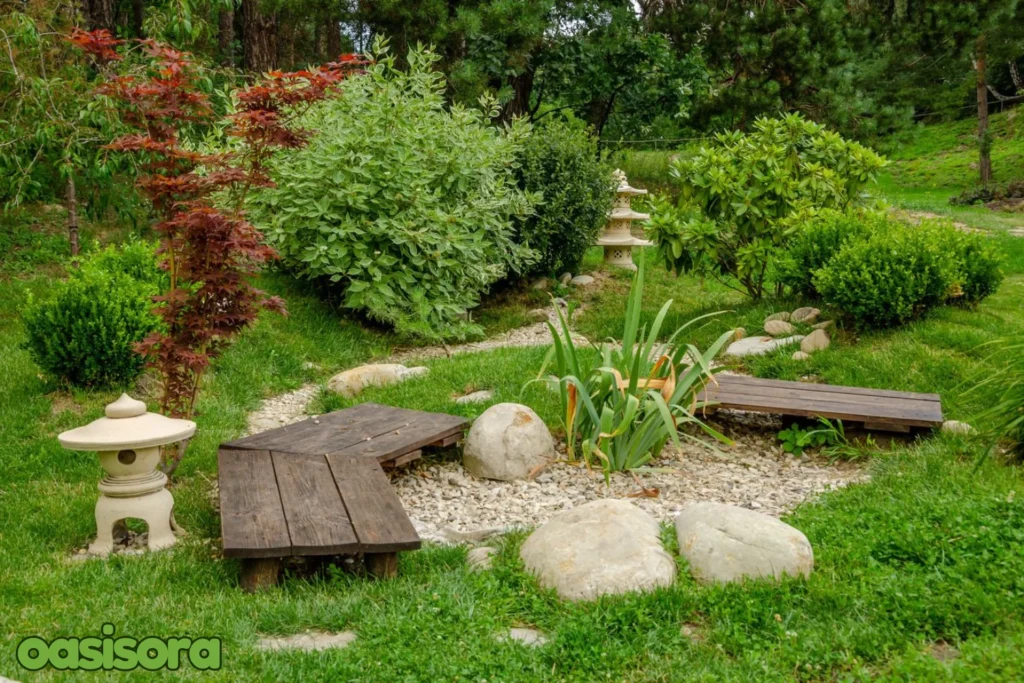
Grass Placement for Japanese Garden
Japanese gardens value stability, peace, and the natural splendor of the environment. The layout of the grass is essential for maximizing the garden’s visual attractiveness and use.
The following are some creative ways to add Japanese garden grass to your outdoors.
- Grass Around Water Features
Surrounding ponds, streams, and waterfalls, grasses like Miscanthus sinensis and Common Reed give a gentle, streaming aspect. Their long, flapping blades move around with the wind, elevating the water’s flow.
Also, these grasses provide an effortless and seamless connection between land and water.
- Creating Contrast with Bold Grasses
Try cultivating Japanese Blood Grass (Imperata cylindrica ‘Red Baron’) in masses for a powerful impact on the eyes.
It is an attractive choice for areas of interest or boundaries along paths with its bold red and green colors, which pair well with the garden’s soft greens. The landscape receives broadness and focus through this contrast.
- Grass as Ground Cover
In rock landscapes and shaded spots, species such as Prairie Dropseed or Evergold Sedge provide eye-catching ground covering.
They give a dense, carpet-like look to your space that creates a peaceful atmosphere. These grasses help in managing weeds and preserving the garden’s tidy, modest appearance.
With mindful grass selection and setting, you may highlight the organic charm of your garden.
Table Comparison of Common Grasses for Japanese Gardens
| Grass Name | Growth Style | Water Needs | Sun Tolerance | Ideal Placement | Features |
| Carex hachijoensis (Evergold Sedge) | Small bunches | Moderate | Partial shade to full sun | Borders, rock gardens, shaded areas | Variegated leaves, low maintenance, pest and disease-resistant |
| Hakonechloa macra (Aureola) | Soft, flowing | High | Partial shade | Under trees, along pathways, shaded gardens | Bright gold leaves, slow-growing, deer resistant, prefer moist soil |
| Imperata cylindrica (Japanese Blood Grass) | Upright | Moderate | Full sun to partial shade | Accent plant, garden edges, containers | Blood-red shaded leaves in fall, non-seeding, |
| Miscanthus sinensis (Chinese Silvergrass) | Tall, bushy | Moderate | Full sun | Background planting, ornamental screens | Spread fast, Cultural significance in Japan used in crafts, |
| Phragmites australis (Common Reed) | Invasive in nature | High | Full sun to partial shade | Avoid planting (highly invasive) | Forms dense stands dominate wetlands and may require professional removal |
| Muhlenbergia capillaris (Pink Muhlygrass) | Light & airy | Low | Full sun | Dry areas, rock gardens, mass plantings | fluffy pink flower plumes, drought-tolerant, low upkeep |
| Schizachyrium scoparium (Little Bluestem) | Upright | Low | Full sun | Natural landscapes, erosion control | Not so tall, disease-resistant, blue-green leaves turn orange in winter |
| Sorghastrum nutans (Indian Grass) | Grows in groups | Low | Full sun | Prairie gardens, meadow plantings | seed heads of plume shape, adaptable to different soils and dryness |
| Sporobolus heterolepis (Prairie Dropseed) | Soft & rounded | Low | Full sun | Dry soils, open spaces, naturalistic gardens | Scented flowers in late summer, slow to establish but long-lived |
Additional Tips for Enhancing Your Japanese Garden
To introduce decorative grasses for making an outstanding Japanese garden, follow these suggestions:
- Combine with Moss and Bamboo: Soft grass supports the growth of lush greenery and aesthetically pleasing grasses with bamboo for fascinating vertical designs.
- Integrate Gravel & Rocks: Place grasses around crushed gravel features and boulders to modernize a Zen garden’s appearance and merge it with the basic layout.
- Water Elements: Grasses near streams or ponds greatly reflect the beauty of water features.
- Layering: Mix grasses with shrubs and trees with varying heights to add depth and style to your outdoor space.
- Seasonal Interest: Pick a grass variety that seasonally changes colour, like Japanese Blood Grass, for iconic beauty.
The precise blending of grasses with classic elements like bamboo, moss, and rocks makes your Japanese garden a calm and classic place that develops tranquillity and purity
Conclusion:
Choosing the Right Grass for Your Japanese Garden
A tranquil, well-balanced landscape requires careful Japanese garden grass selection and maintenance. The proper grasses enrich trees, rocks, and water components while bringing texture and symmetry.
Opt for Japanese Blood Grass to create remarkable contrast to establish aesthetics and functionality, while colorful grasses like Hakonechloa macra reflect places that get shade.
Preserve ecosystems by avoiding invasive varieties and prefer drought-tolerant, low-maintenance alternatives where necessary.
A serene, classic setting that represents traditional Japanese garden standards is made possible by carefully planned grass planting. Making the right decisions will end up in your peaceful, beautifully designed oasis that will thrive for several years to come.

3 thoughts on “9 Best Japanese Garden Grass Choices for Peaceful Gardens”
Comments are closed.